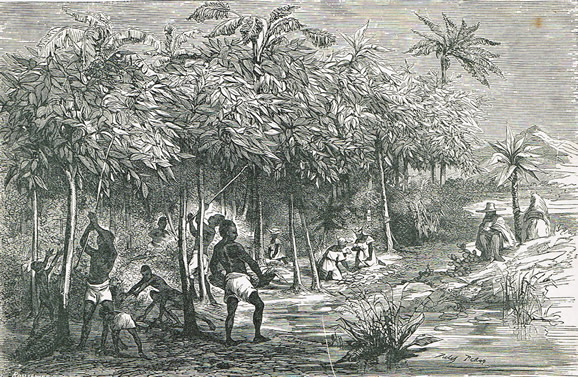Colonial Production
Theobroma cacao originally grew in the Amazon rainforest and spread around South America as a wild plant in the Amazon basin. During the 16th century Portuguese colonists and pioneers discovered this crop as a luxurious good for Portugal. The Portuguese decided to increase production of the crop across two continents. As a result of growing Brazilian independence and a desperate desire to keep a monopoly on the plantation system of cacao. This plantation system has proved very lucrative for Portugal who are still exploiting the production of this crop off of forced labor to this day. How did Theobroma cacao become the dominant production of cacao in two Portuguese controlled continents. This essay will focus first production of Theobroma cacao in Brazil, cacao research by the society of Jesus which used slave labor and finally the Columbian exchange.
In the beginning, cacao was in the wild along the rivers of the amazon. The Tupi natives and other native societies gathered cacao pods from the wild cacao trees and used this crop for food and medicinal needs. The tribes never needed to cultivate this wild crop as there was plenty to keep the societies sufficient. This chocolate was able to provide enough nutrients for natives and thus they were given enough strength to combat hunger.
The European craving for chocolate began in the 17th century, with its high value and nutritional benefits the Portuguese saw an opportunity to be a part of this lucrative market of cacao. We began in Salvador de Bahia, which was the first location where cacao was systematically cultivated. Brazilian cacao was first planted and organized in large farms instead of growing them in the wild. The first systems were used by the Jesuits and the society of Jesus who were researching the cacao for its medicinal value.
In the 16th century, the Jesuits identified the medicinal value of cacao. This developed an interest in the values of cacao as a result of plagues affecting Europe back home and to potentially look for a cure. The society of Jesus established a mission near Bahia where they used that missionary where they could transport cacao from the Amazon jungle. It was only at Jesuit pharmacies that they were able to turn cacao into a medicinal substance for use. The missions were able to extract the cacao butter and sold the butter as skin care to consumers. As a result of this research was used in military hospitals across the Portuguese empire as the medicine prevented heat rashes and disorders like shingles. Across the empire, cacao served a medicinal purpose and also served as a cash crop. The society of Jesus needed a better way to gain revenue from the sale of cacao. Due to this demand for more profit, production was increased for cacao in the Amazon. The labor used for the production of cacao was mostly native Americans and then followed by slave labor from Africa.
The Columbian exchange which started with the Portuguese saw the displacement of millions of Africans to the Americas and other parts of the globe. These Africans were intentionally divided between tribal languages so they cannot communicate with one another and thus resistance would be futile. The slave labor brought in from Africa was meant to replace the existing native American labor as the native Americans put up more resistance to the forced labor. The promise of further profit in the industry prompted the Portuguese royal king to ship cacao seeds to islands in Africa. This was the first attempt to transport cacao and produce the product outside of Brazil. Another reason which cacao production was expanded was that as the Brazilian independence movement grew in strength, the Portuguese sought to move the production of cacao across the continent to Africa to ensure they still held a monopoly of the luxury goods.
In conclusion, the Theobroma cacao is one of the dominant products of chocolate which still exists to this day. As evidence has shown that under the Portuguese empire the Theobroma cacao became a dominant cacao product in two continents. We looked at first production of Theobroma cacao in Brazil, cacao research by the society of Jesus which used slave labor and finally the Columbian exchange. In Ghana and other parts of equatorial Africa which produce up to 70 percent of the world's chocolate, many Africans are still exploited under forced labor there. The Portuguese and other western chocolate companies still hold a monopoly over the production of Theobroma cacao.
Bibliography:
Walker, Timothy. “Cure or Confection?” In Chocolate, 561–68. Hoboken, NJ, USA: John Wiley & Sons, Inc, 2009. https://doi.org/10.1002/9780470411315.ch41.

Comments
Post a Comment